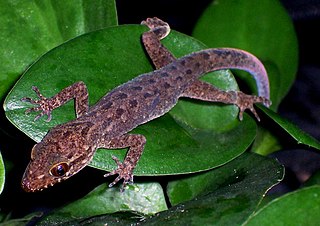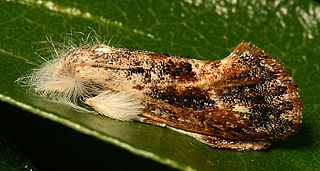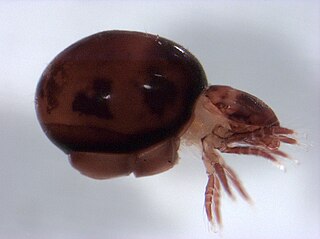
The bird family Tytonidae, which includes the barn owlsTyto and the bay owlsPhodilus, is one of the two families of owls, the other being the true owls or typical owls, Strigidae. They are medium to large owls with large heads and characteristic heart-shaped faces. They have long, strong legs with powerful talons. They also differ from the Strigidae in structural details relating in particular to the sternum and feet.
The barn owls are the most widely distributed group of owls in the world. They are medium-sized owls with large heads and characteristic heart-shaped faces. They have long, strong legs with powerful talons. The term may be used to describe:

Cyrtodactylus is a diverse genus of Asian geckos, commonly known as bent-toed geckos, bow-fingered geckos, and forest geckos. The genus has 361 described species as of 2024, which makes it the largest of all gecko genera.

The Pentatomoidea are a superfamily of insects in the suborder Heteroptera of the order Hemiptera. As hemipterans, they possess a common arrangement of sucking mouthparts. The roughly 7000 species under Pentatomoidea are divided into 21 families. Among these are the stink bugs and shield bugs, jewel bugs, giant shield bugs, and burrower bugs.

Incertae sedis or problematica is a term used for a taxonomic group where its broader relationships are unknown or undefined. Alternatively, such groups are frequently referred to as "enigmatic taxa". In the system of open nomenclature, uncertainty at specific taxonomic levels is indicated by incertae familiae, incerti subordinis, incerti ordinis and similar terms.

Tyto is a genus of birds consisting of true barn owls, grass owls and masked owls that collectively make up all the species within the subfamily Tytoninae of the barn owl family, Tytonidae.

The Lestidae are a rather small family of cosmopolitan, large-sized, slender damselflies, known commonly as the spreadwings or spread-winged damselflies.

Acrolophinae is a family of moths in the order Lepidoptera. The subfamily comprises the burrowing webworm moths and tube moths and holds about 300 species in five genera, which occur in the wild only in the New World. It is closely related to the family Tineidae.

Oribatida, also known as oribatid mites, moss mites or beetle mites, are an order of mites, in the "chewing Acariformes" clade Sarcoptiformes. They range in size from 0.2 to 1.4 millimetres. There are currently 12,000 species that have been identified, but researchers estimate that there may be anywhere from 60,000 to 120,000 total species. Oribatid mites are by far the most prevalent of all arthropods in forest soils, and are essential for breaking down organic detritus and distributing fungi.

The African grass owl or simply grass owl is a species of owl in the barn owl family, Tytonidae.

The eastern grass owl, also known as Chinese grass owl or Australasian grass owl, is a species of owl in the family Tytonidae. They feed predominantly on small rodents.

George Henry Horn was an American entomologist who specialized in the study of beetles.
Trachelostenus is a genus of darkling beetles in the family Tenebrionidae. It is native to the Valdivian forests of Chile, and has at least two species, T. inaequalis (Solier) and T. fascicularis (Philipp). It was historically considered the only member of the family Trachelostenidae, but a 2015 study sunk the genus into the tenebrionid subfamily Tenebrioninae.

The Andaman masked owl is a barn owl endemic to the southern Andaman Islands archipelago of India, in the Bay of Bengal, Indian Ocean. Regarded by some authors as a subspecies of the common barn owl, it is recognized by others as a species in its own right.
The Seram masked owl is an owl species in the family Tytonidae endemic to Seram Island in Indonesia. After being first brought to the attention of the world from a photograph taken during an expedition by Rudi Badil and Sukianto Lusli in the Manusela National Park in Seram in 1987 the holotype was mist-netted on 10 February 2012 and this species was formally described in 2013. The species' epithet commemorates Alma Jønsson, the daughter of Knud Andreas Jønsson, one of the describers of the Seram masked owl.
Pinthaeus is a genus of stink bugs.

Rivero's barn owl is an extinct species of barn owl that was very large — bigger than any extant barn owl species, and possibly larger than any known owl alive today. It is thought to have been nearly as large as another extinct gigantic owl, Ornimegalonyx. Suárez and Olson demoted T. riveroi as a junior synonym of Tyto pollens in 2015.

Lyctocoridae is a reconstituted family of bugs, formerly classified within the minute pirate bugs of the family Anthocoridae. It is widely distributed, with one species, being cosmopolitan.
Iphigenellidae is a freshwater family of amphipods in the superfamily Gammaroidea. It is found in the Ponto-Caspian region, which encompasses the Black, Azov, and Caspian Seas.












